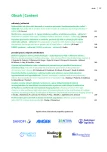Diuretic treatment in patients with acute pulmonary edema did not produces severe hyponatremia or hypokalemia
Authors:
Jozef Kalužay; Veronika Pokorná; Svetlana Bodíková; Natália Vahančíková; Peter Ponťuch
Authors‘ workplace:
IV. interná klinika LF UK a UN Bratislava, Nemocnica sv. Cyrila a Metoda, Slovenská republika
Published in:
Vnitř Lék 2016; 62(4): 263-267
Category:
Original Contributions
Overview
Introduction:
One of the risks of diuretic therapy for pulmonary edema is the development of hyponatremia and hypokalemia with pro-arrhythmic potential. The aim of our study was to analyze the incidence of hyponatremia and hypokalemia after the first day of treatment in a real clinical practice.
Methods:
We performed a retrospective analysis of data obtained from medical records. We included all patients with pulmonary edema admitted to the coronary care unit, only patients which died within the first day of treatment were excluded. Absolute dose of administered furosemide, total fluid intake and urine output, saline and pottasium intake were analyzed. Nonparametric paired Wilcoxon test was used to compare natrium and pottasium levels changes.
Results:
37 patients were included into analysis. The median dose of furosemide administered during the first day of treatment was 120 mg (IQR 20–300 mg). Median diuresis was 2 400 ml (IQR 1 425–3 225 ml). The median of difference between diuresis and total fluid intake was 315 ml (IQR 538–1 380 ml). Wilcoxon test confirmed a prevailing statistically significant trend of slight rise in serum sodium within the first day of treatment (serum sodium 138.0 IQR 132.8–139.6 vs 138.1 IQR 134,0–141,7 mmol/l, p = 0.0046). The difference in serum potassium was not statistically significant (serum potassium 4.2 IQR 3.9–4.8 vs 4.2, IQR 3.8–4.8 mmol/l).
Conclusion:
Results did not confirmed the need for a substitution of sodium and potassium losses during the first day of diuretic therapy to prevent hyponatriemia and hypokalemia in patients with pulmonary edema.
Key words:
furosemide – hyponatremia – pulmonary edema
Sources
1. Llorens P, Miró Ó, Herrero P et al. Clinical effects and safety of different strategies for administering intravenous diuretics in acutely decompensated heart failure: a randomised clinical trial. Emerg Med J 2014; 31(9): 706–713.
2. Felker GM, Lee KL, Bull DA et al. Diuretic strategies in patients with acute decompensated heart failure. N Engl J Med 2011; 364(9): 797–805.
3. Pickkers P, Dormans TP, Russel FG et al. Direct vascular effects of furosemide in humans. Circulation 1997; 96(6): 1847–1852.
4. Wakai A, McCabe A, Kidney R et al. Nitrates for acute heart failure syndromes. Cochrane Database Syst Rev 2013; 8: CD005151. Dostupné z DOI: http://dx.doi.org/10.1002/14651858.CD005151.pub2.
5. Holzer-Richling N, Holzer M, Herkner H et al. Randomized placebo controlled trial of furosemide on subjective perception of dyspnoea in patients with pulmonary oedema because of hypertensive crisis. Eur J Clin Invest 2011; 41(6): 627–634.
6. Cotter G, Metzkor E, Kaluski E et al. Randomised trial of high-dose isosorbide dinitrate plus low-dose furosemide versus high-dose furosemide plus low-dose isosorbide dinitrate in severe pulmonary oedema. Lancet 1998; 351(9100): 389–393.
7. McMurray JJ, Adamopoulos S, Anker SD et al. ESC Guidelines for the diagnosis and treatment of acute and chronic heart failure 2012: The Task Force for the Diagnosis and Treatment of Acute and Chronic Heart Failure 2012 of the European Society of Cardiology. Developed in collaboration with the Heart Failure Association (HFA) of the ESC. Eur Heart J 2012; 33(14): 1787–1847. Erratum in Eur Heart J 2013; 34(2): 158.
8. Shah RV, McNulty S, O’Connor CM et al. Effect of admission oral diuretic dose on response to continuous versus bolus intravenous diuretics in acute heart failure: an analysis from diuretic optimization strategies in acute heart failure. Am Heart J 2012; 164(6): 862–868.
9. Gallusova J, Halacova M, Cerny D. Optimal way of administration of high dose intravenous furosemide – continuous infusion or bolus? Vnitř Lék 2014; 60(10): 885–892.
10. Verbrugge FH, Tang WH, Mullens W. Renin-Angiotensin-aldosterone system activation during decongestion in acute heart failure: friend or foe? JACC Heart Fail 2015; 3(2): 108–111.
11. De Vecchis R, Esposito C, Ariano C et al. Hypertonic saline plus i.v. furosemide improve renal safety profile and clinical outcomes in acute decompensated heart failure: A meta-analysis of the literature. Herz 2015; 40(3): 423–435.
12. Ali J, Duke K. Colloid osmotic pressure in pulmonary edema clearance with furosemide. Chest 1987; 92(3): 540–546.
13. Kuwahara T, Asanami S, Kubo S. Experimental infusion phlebitis: tolerance osmolality of peripheral venous endothelial cells. Nutrition 1998; 14(6): 496–501.
14. Matthay MA, Folkesson HG, Clerici C. Lung epithelial fluid transport and the resolution of pulmonary edema. Physiol Rev 2002; 82(3): 569–600.
Labels
Diabetology Endocrinology Internal medicineArticle was published in
Internal Medicine

2016 Issue 4
Most read in this issue
- DRESS syndrome
-
PCSK9 inhibitors – new possibilities in the treatment of hypercholesterolemia: For which patients will be indicated?
Czech atherosclerosis society statement - Beta-blockers and chronic obstructive pulmonary disease
- Chronic kidney diseases, metformin and lactic acidosis
